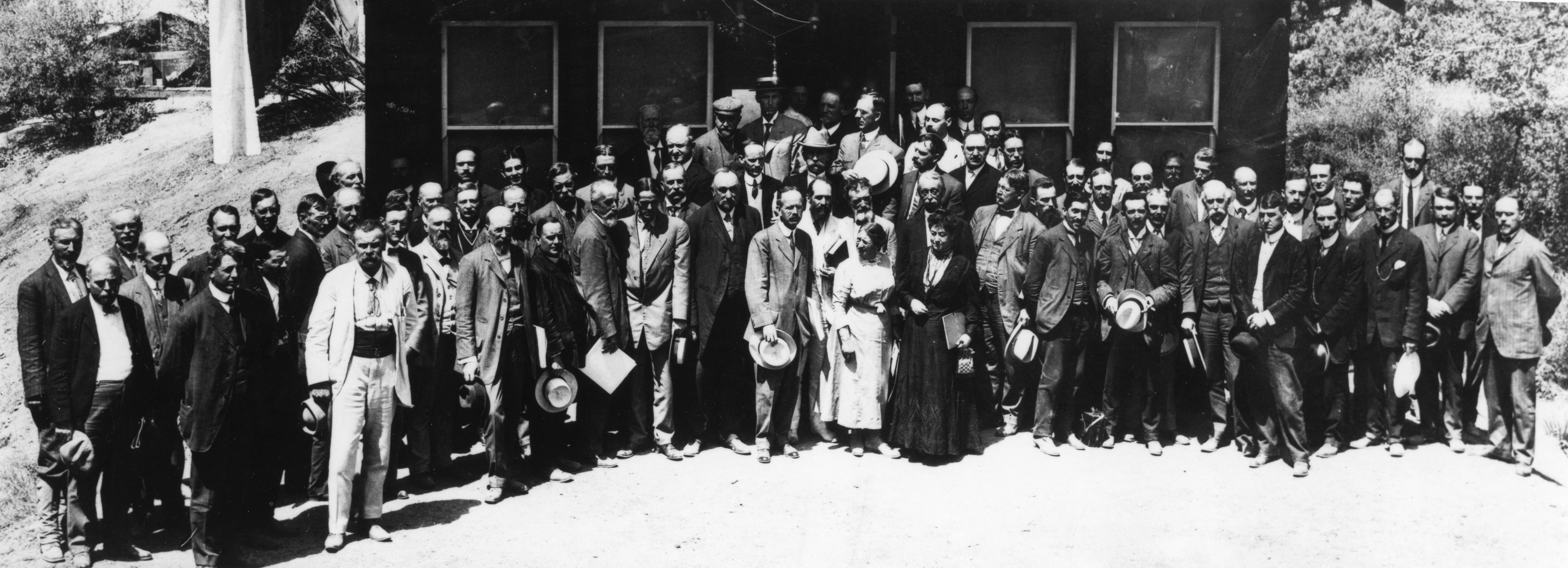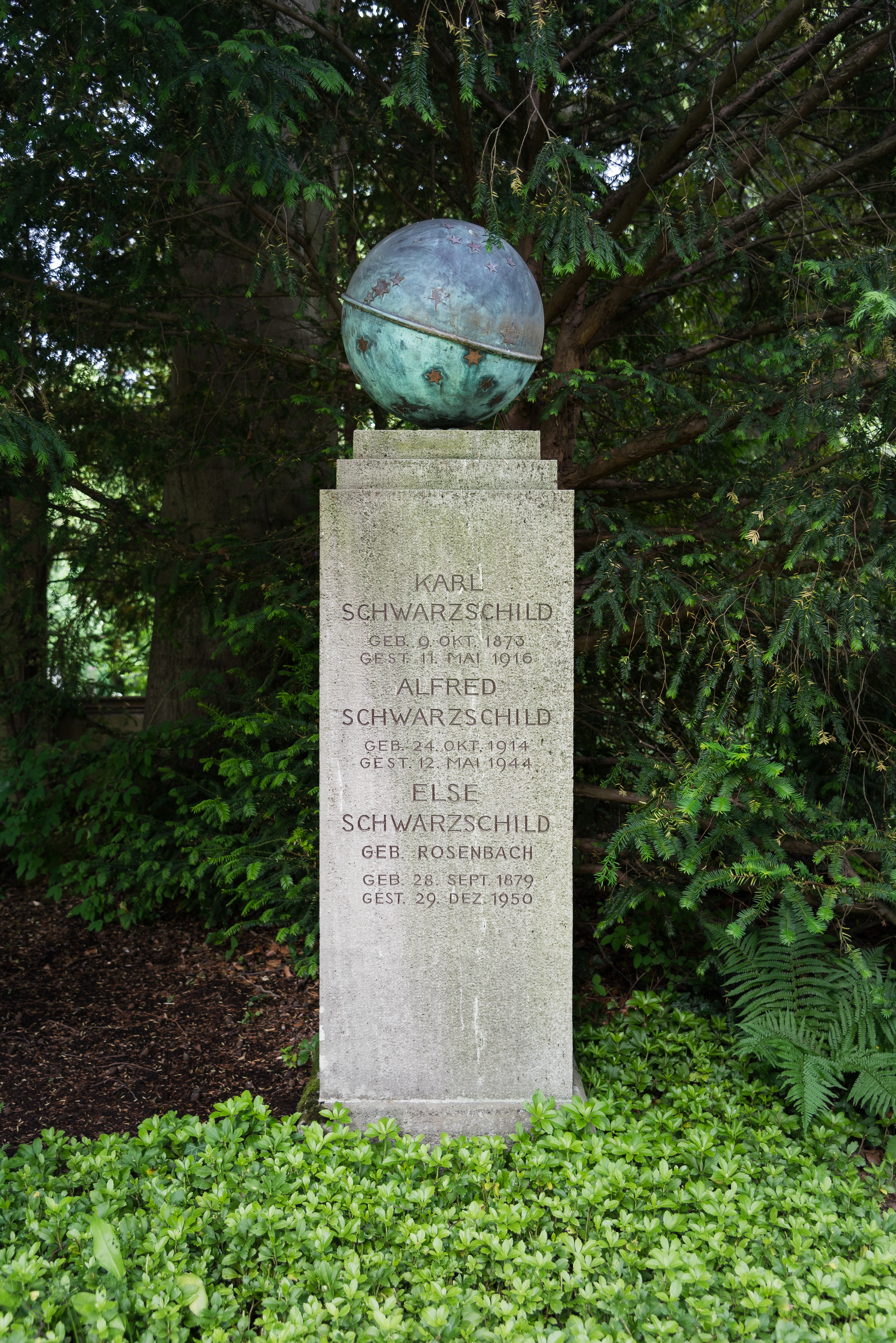1. Overview
Karl Schwarzschild was a pioneering German physicist and astronomer who made groundbreaking contributions to the fields of general relativity, celestial mechanics, and astrophotography. Born on October 9, 1873, in Frankfurt am Main, he is most renowned for providing the first exact solution to Albert Einstein's Einstein field equations of general relativity in 1915, the same year Einstein introduced the theory. This solution, known as the Schwarzschild solution, utilized Schwarzschild coordinates and the Schwarzschild metric, leading to the derivation of the Schwarzschild radius, which defines the event horizon of a non-rotating black hole.
Beyond his work in relativity, Schwarzschild's research interests were exceptionally broad. He standardized stellar photometry using photography, developed the Schwarzschild law and Schwarzschild exponent for photographic materials, and made significant advancements in instrumental astronomy and spectroscopy. He also introduced the correct Lagrangian formalism of the electromagnetic field and a field-free variational formulation of electrodynamics. His work on stellar structure, stellar statistics, and the physics of Halley's Comet further showcased his diverse scientific talents. Schwarzschild achieved these remarkable feats while serving in the German army during World War I, where he contributed to ballistic calculations. Tragically, he contracted the rare autoimmune skin disease pemphigus on the Russian front and died on May 11, 1916, at the age of 42. His legacy is honored through the naming of Asteroid 837 Schwarzschilda, the Schwarzschild crater on the Moon, and the prestigious Karl Schwarzschild Medal awarded by the German Astronomical Society. He was also the father of the distinguished astrophysicist Martin Schwarzschild.
2. Life
Karl Schwarzschild's life was marked by early intellectual brilliance, a distinguished academic career, and a tragic end influenced by global conflict.
2.1. Early Life and Background
Karl Schwarzschild was born on October 9, 1873, in Frankfurt am Main, German Empire. He was the eldest of six boys and one girl in a prominent Jewish family. His father was an active member of the city's business community, and the Schwarzschild family had a long history in Frankfurt, with ancestors tracing back to the sixteenth century. The family owned two fabric stores in Frankfurt. His brother, Alfred Schwarzschild, became a painter, but tragically remained in Nazi Germany and was murdered during the Holocaust.
The young Schwarzschild attended a Jewish primary school until the age of 11 before enrolling in the Lessing-Gymnasium, a secondary school in Frankfurt. There, he received a comprehensive education that included subjects such as Latin, Ancient Greek, music, and art. However, it was astronomy that captured his special interest early on. He demonstrated an extraordinary aptitude for science, proving to be something of a child prodigy by publishing two papers on binary orbits in celestial mechanics before he turned sixteen.
2.2. Education
After graduating from the Lessing-Gymnasium in 1890, Schwarzschild pursued his passion for astronomy at the University of Strasbourg. After two years, he transferred to the Ludwig Maximilian University of Munich, where he completed his doctoral studies. In 1896, he was awarded his doctorate for his work on the theories of Henri Poincaré, a renowned French mathematician and theoretical physicist. His academic pursuits at these institutions laid the foundational knowledge for his future groundbreaking contributions to physics and astronomy.
2.3. Career Development
Schwarzschild's professional career began in 1897 when he became an assistant at the Kuffner Observatory in Vienna. During his tenure there, he primarily focused on the photometry of star clusters. His research at Kuffner laid the groundwork for a fundamental formula that connected the intensity of starlight, exposure time, and the resulting contrast on a photographic plate. A key component of this theory was the development of the Schwarzschild exponent, which became an important concept in astrophotography. In 1899, he returned to Munich to complete his Habilitation, a post-doctoral qualification required for professorship in Germany.
From 1901 to 1909, Schwarzschild held a professorship at the prestigious Göttingen Observatory within the University of Göttingen. During this period, he also served as the director of the observatory. This position provided him with the invaluable opportunity to collaborate with other significant scientific figures of his time, including the mathematicians David Hilbert and Hermann Minkowski. In 1909, he moved to Potsdam to assume the directorship of the Astrophysical Observatory Potsdam, which was considered the most prestigious post available for an astronomer in Germany at that time. In 1912, recognizing his immense contributions to science, Schwarzschild was elected as a member of the Prussian Academy of Sciences. Throughout his early career, he was known to have focused intensely on calculations related to planetary orbits.


2.4. Personal Life
In 1909, Karl Schwarzschild married Else Rosenbach. Else was the great-granddaughter of the distinguished German chemist Friedrich Wöhler and the daughter of a professor of surgery at the University of Göttingen. Together, Karl and Else had three children. Their eldest daughter, Agathe Thornton (1910-2006), emigrated to Great Britain in 1933 and later moved to New Zealand in 1946, where she became a classics professor at the University of Otago in Dunedin. Their son, Martin Schwarzschild (1912-1997), followed in his father's footsteps, becoming a highly respected astrophysicist and a professor of astronomy at Princeton University. Martin Schwarzschild is particularly known for his significant contributions to the field of stellar evolution, including his influential book The Structure and Evolution of Stars (1958). Their youngest son, Alfred Schwarzschild (1914-1944), tragically remained in Nazi Germany and was murdered during the Holocaust, a stark reminder of the immense human cost of that period.
2.5. Military Service and Illness
At the outbreak of World War I in 1914, Karl Schwarzschild, despite being over 40 years old, volunteered for service in the German army. He served on both the Western and Eastern Fronts, where his scientific expertise was utilized for ballistics calculations, contributing to artillery precision. He rose to the rank of second lieutenant in the artillery.
While stationed on the Russian front in 1915, Schwarzschild began to suffer from pemphigus, a rare and painful autoimmune disease that affects the skin. Despite the debilitating nature of his illness, he continued his intellectual work, managing to write three significant papers during this period: two on the theory of relativity and one on quantum theory. His papers on relativity were particularly groundbreaking, as they produced the first exact solutions to the Einstein field equations, with a minor modification of these results leading to the well-known solution that now bears his name-the Schwarzschild metric.
In March 1916, due to the severity of his illness, Schwarzschild was discharged from military service and returned to Göttingen. However, his struggle with pemphigus proved fatal. Two months later, on May 11, 1916, Karl Schwarzschild died at the age of 42. He is interred in his family grave at the Stadtfriedhof Göttingen.

3. Scientific Contributions
Karl Schwarzschild's scientific contributions were remarkably diverse and profound, spanning multiple fields of physics and astronomy.
3.1. Broad Research Interests
While Karl Schwarzschild is most widely recognized for his seminal work in general relativity, his research interests were exceptionally broad, encompassing a wide array of topics in physics and astronomy. His extensive portfolio included significant work in celestial mechanics, observational stellar photometry, quantum mechanics, instrumental astronomy, stellar structure, stellar statistics, and spectroscopy. He also conducted research on specific celestial objects, such as Halley's Comet.
Among his particular achievements were the precise measurements of variable stars, which he conducted using photographic techniques. He also made notable improvements to optical systems through his perturbative investigations of geometrical aberrations, enhancing the accuracy and capabilities of astronomical instruments. Furthermore, he developed theories concerning the formation of absorption lines in stellar spectra and proposed a theory describing the elliptical velocity distribution within star clusters.
3.2. Physics of Photography
While working at the Kuffner Observatory in Vienna in 1897, Schwarzschild conducted pioneering research in the physics of photography, specifically focusing on its application in astronomy. He developed a fundamental formula, now known as the Schwarzschild law, which is used to calculate the optical density of photographic material. This law incorporates an exponent, referred to as the Schwarzschild exponent, denoted as p, within the formula:
`i = f ( I * t^p )`
In this equation, i represents the optical density of the exposed photographic emulsion, which is a function of I, the intensity of the observed light source, and t, the exposure time. The constant p accounts for the non-linear response of photographic emulsions at very low light levels or very long exposure times, a phenomenon known as reciprocity failure. This formula was critically important for enabling more accurate photographic measurements of the intensities of faint astronomical sources, thereby standardizing stellar photometry using photographic methods.
3.3. Electrodynamics
Karl Schwarzschild also made significant contributions to the field of electrodynamics. According to the renowned physicist Wolfgang Pauli, Schwarzschild was the first to introduce the correct Lagrangian formalism of the electromagnetic field. This formulation describes the action (S) as an integral involving the electric (E) and magnetic (H) fields, as well as terms related to charge density (rho), electric potential (phi), vector potential (A), and velocity (u). This work provided a more rigorous mathematical framework for describing electromagnetic phenomena.
Furthermore, Schwarzschild introduced a field-free variational formulation of electrodynamics, often referred to as "action at a distance" or "direct interparticle action." This formulation is based solely on the world lines of particles. It posits that two points on different world lines contribute to the Lagrangian (i.e., are coupled) only if they are separated by a zero Minkowskian distance, meaning they are connected by a light ray. This revolutionary idea was later further developed by physicists such as Hugo Tetrode and Adriaan Fokker in the 1920s, and most notably by John Archibald Wheeler and Richard Feynman in the 1940s. Schwarzschild's formulation provided an alternative, yet mathematically equivalent, approach to classical electrodynamics.
3.4. General Relativity
Karl Schwarzschild's most celebrated achievements lie in his groundbreaking research concerning Albert Einstein's theory of general relativity. His work provided the first exact solutions to Einstein's complex field equations, a feat that surprised even Einstein himself.

At the time, Einstein had only managed to produce an approximate solution to his field equations, which he presented in his famous 1915 article on the advance of the perihelion of Mercury. In that work, Einstein used rectangular coordinates to approximate the gravitational field around a spherically symmetric, non-rotating, non-charged mass. Schwarzschild, however, adopted a more elegant "polar-like" coordinate system, which enabled him to derive an exact solution.
3.4.1. Schwarzschild Solution
Schwarzschild communicated his first exact solution to Einstein in a letter dated December 22, 1915, written while he was serving on the Russian front during World War I. He famously concluded the letter by stating, "As you see, the war is kindly disposed toward me, allowing me, despite fierce gunfire at a decidedly terrestrial distance, to take this walk into this your land of ideas." Einstein was deeply impressed by Schwarzschild's work, writing back in 1916:
:I have read your paper with the utmost interest. I had not expected that one could formulate the exact solution of the problem in such a simple way. I liked very much your mathematical treatment of the subject. Next Thursday I shall present the work to the Academy with a few words of explanation.
Einstein subsequently presented Schwarzschild's paper to the Prussian Academy of Sciences on his behalf.
Schwarzschild's solution describes the spacetime geometry around a non-rotating, spherically symmetric mass, such as a star or a black hole, by mathematically compressing the mass. It is derived using Schwarzschild coordinates and the Schwarzschild metric. His second paper on the subject presented what is known as the "Inner Schwarzschild solution" (innere Schwarzschild-Lösunginner Schwarzschild solutionGerman). This solution is valid within a sphere of homogeneously and isotropically distributed molecules within a shell of radius r = R. It is applicable to various physical systems, including solids, incompressible fluids, and even the Sun and stars when viewed as quasi-isotropic heated gases, or any homogeneously and isotropically distributed gas.

3.4.2. Schwarzschild Radius and Black Holes
A crucial outcome of Schwarzschild's first (spherically symmetric) solution is the derivation of the Schwarzschild radius. In his coordinates, this solution does not contain a coordinate singularity on the surface that is now named after him. Instead, this singularity lies on the sphere of points at a particular radius, defined by the formula:
`Rs = 2GM/c2`
where G is the gravitational constant, M is the mass of the central body, and c is the speed of light in vacuum.
The Schwarzschild radius represents a critical boundary. In cases where the radius of the central body is less than its Schwarzschild radius, `Rs` signifies the radius within which all massive bodies, and even photons, must inevitably fall into the central body, disregarding quantum tunnelling effects near the boundary. This concept was revolutionary as it implied the existence of objects from which nothing, not even light, could escape.
When the mass density of a central body exceeds a specific limit, it triggers a gravitational collapse. If this collapse occurs with spherical symmetry, it leads to the formation of what is now known as a Schwarzschild black hole. A notable example of this phenomenon occurs when the mass of a neutron star surpasses the Tolman-Oppenheimer-Volkoff limit, which is approximately three solar masses. Schwarzschild's work thus laid the foundational theoretical framework for understanding gravitational collapse and the subsequent development of black hole theory.
3.5. Other Contributions
Beyond his pivotal work in general relativity, Schwarzschild made specific and notable contributions to other scientific fields. In celestial mechanics, his early work as a child prodigy included publishing papers on binary orbits before the age of sixteen, demonstrating his early grasp of complex astronomical calculations. In the realm of quantum theory, despite his severe illness during World War I, he managed to write a significant paper on the subject, showcasing his versatility and intellectual resilience across different branches of theoretical physics. He also focused on planetary orbit calculations in his youth, and developed theories on stellar absorption line formation and the elliptical velocity distribution of star clusters.
4. Legacy and Recognition
Karl Schwarzschild's scientific achievements have left an indelible mark on the fields of physics and astronomy, leading to lasting recognition and a profound influence on subsequent generations of scientists.
4.1. Honors and Memorials
In recognition of his groundbreaking achievements, several honors and memorials have been established or named in Karl Schwarzschild's memory:
- Asteroid 837 Schwarzschilda**: An asteroid discovered in 1917 is named in his honor.
- Schwarzschild crater**: A large lunar crater located on the far side of the Moon bears his name.
- Karl Schwarzschild Medal**: The German Astronomical Society (Astronomische Gesellschaft) established this prestigious award, also known as the Karl Schwarzschild Prize, which is bestowed upon astronomers for outstanding achievements in the field.
4.2. Influence
Karl Schwarzschild's research, particularly his exact solution to Einstein's field equations, has had a profound and lasting impact on the fields of astronomy and physics. Thousands of dissertations, articles, and books have since been devoted to the study and implications of his solutions, underscoring their fundamental importance. His work provided the theoretical basis for the existence and understanding of black holes, a concept that continues to be a central area of research in modern astrophysics.
His family also carried on a significant scientific legacy. His son, Martin Schwarzschild, became a distinguished astrophysicist at Princeton University, making crucial contributions to the understanding of stellar evolution and authoring influential texts in the field. This familial continuation of scientific excellence further cemented the Schwarzschild name in the annals of astronomy.
4.3. Cultural References
Karl Schwarzschild's name and his groundbreaking achievements have also permeated popular culture, appearing in various literary works:
- He appears as a character in "Schwarzschild Radius," a 1987 science fiction short story by Connie Willis.
- He is featured as a fictionalized character in the story "Schwarzchild's Singularity," part of the 2020 collection When We Cease to Understand the World by Benjamín Labatut.
- His contributions, particularly regarding black holes, were highlighted in Episode 3, "Approach Black Hole," of the 1990 NHK Special "Galaxy Space Odyssey."
5. Works
The entire scientific estate of Karl Schwarzschild is preserved and stored in a special collection at the Lower Saxony National- and University Library of Göttingen. His major scientific papers and publications include:
Relativity
- Über das Gravitationsfeld eines Massenpunktes nach der Einstein'schen Theorie. (Reimer, Berlin, 1916, S. 189 ff. (Sitzungsberichte der Königlich-Preussischen Akademie der Wissenschaften; 1916))
- Über das Gravitationsfeld einer Kugel aus inkompressibler Flüssigkeit. (Reimer, Berlin, 1916, S. 424-434 (Sitzungsberichte der Königlich-Preussischen Akademie der Wissenschaften; 1916))
Other Papers
- Untersuchungen zur geometrischen Optik I. Einleitung in die Fehlertheorie optischer Instrumente auf Grund des Eikonalbegriffs (1906, Abhandlungen der Gesellschaft der Wissenschaften in Göttingen, Band 4, Nummero 1, S. 1-31)
- Untersuchungen zur geometrischen Optik II. Theorie der Spiegelteleskope (1906, Abhandlungen der Gesellschaft der Wissenschaften in Göttingen, Band 4, Nummero 2, S. 1-28)
- Untersuchungen zur geometrischen Optik III. Über die astrophotographischen Objektive (1906, Abhandlungen der Gesellschaft der Wissenschaften in Göttingen, Band 4, Nummero 3, S. 1-54)
- Über Differenzformeln zur Durchrechnung optischer Systeme (1907, Nachrichten von der Gesellschaft der Wissenschaften zu Göttingen, S. 551-570)
- Aktinometrie der Sterne der B. D. bis zur Größe 7.5 in der Zone 0° bis +20° Deklination. Teil A. Unter Mitwirkung von Br. Meyermann, A. Kohlschütter und O. Birck (1910, Abhandlungen der Gesellschaft der Wissenschaften in Göttingen, Band 6, Numero 6, S. 1-117)
- Über das Gleichgewicht der Sonnenatmosphäre (1906, Nachrichten von der Gesellschaft der Wissenschaften zu Göttingen, S. 41-53)
- Die Beugung und Polarisation des Lichts durch einen Spalt. I. (1902, Mathematische Annalen, Band 55, S. 177-247)
- Zur Elektrodynamik. I. Zwei Formen des Princips der Action in der Elektronentheorie (1903, Nachrichten von der Gesellschaft der Wissenschaften zu Göttingen, S. 126-131)
- Zur Elektrodynamik. II. Die elementare elektrodynamische Kraft (1903, Nachrichten von der Gesellschaft der Wissenschaften zu Göttingen, S. 132-141)
- Zur Elektrodynamik. III. Ueber die Bewegung des Elektrons (1903, Nachrichten von der Gesellschaft der Wissenschaften zu Göttingen, S. 245-278)
- Ueber die Eigenbewegungen der Fixsterne (1907, Nachrichten von der Gesellschaft der Wissenschaften zu Göttingen, S. 614-632)
- Ueber die Bestimmung von Vertex und Apex nach der Ellipsoidhypothese aus einer geringeren Anzahl beobachteter Eigenbewegungen (1908, Nachrichten von der Gesellschaft der Wissenschaften zu Göttingen, S. 191-200)
- K. Schwarzschild, E. Kron: Ueber die Helligkeitsverteilung im Schweif des Halley´schen Kometen (1911, Nachrichten von der Gesellschaft der Wissenschaften zu Göttingen, S. 197-208)
- Die naturwissenschaftlichen Ergebnisse und Ziele der neueren Mechanik. (1904, Jahresbericht der Deutschen Mathematiker-Vereinigung, Band 13, S. 145-156)
- Über die astronomische Ausbildung der Lehramtskandidaten. (1907, Jahresbericht der Deutschen Mathematiker-Vereinigung, Band 16, S. 519-522)
English Translations
- On the Gravitational Field of a Point-Mass, According to Einstein's Theory (The Abraham Zelmanov Journal, 2008, Volume 1, P. 10-19)
- On the Gravitational Field of a Sphere of Incompressible Liquid, According to Einstein's Theory (The Abraham Zelmanov Journal, 2008, Volume 1, P. 20-32)
- On the Permissible Numerical Value of the Curvature of Space (The Abraham Zelmanov Journal, Volume 1, 2008, pp. 64-73)